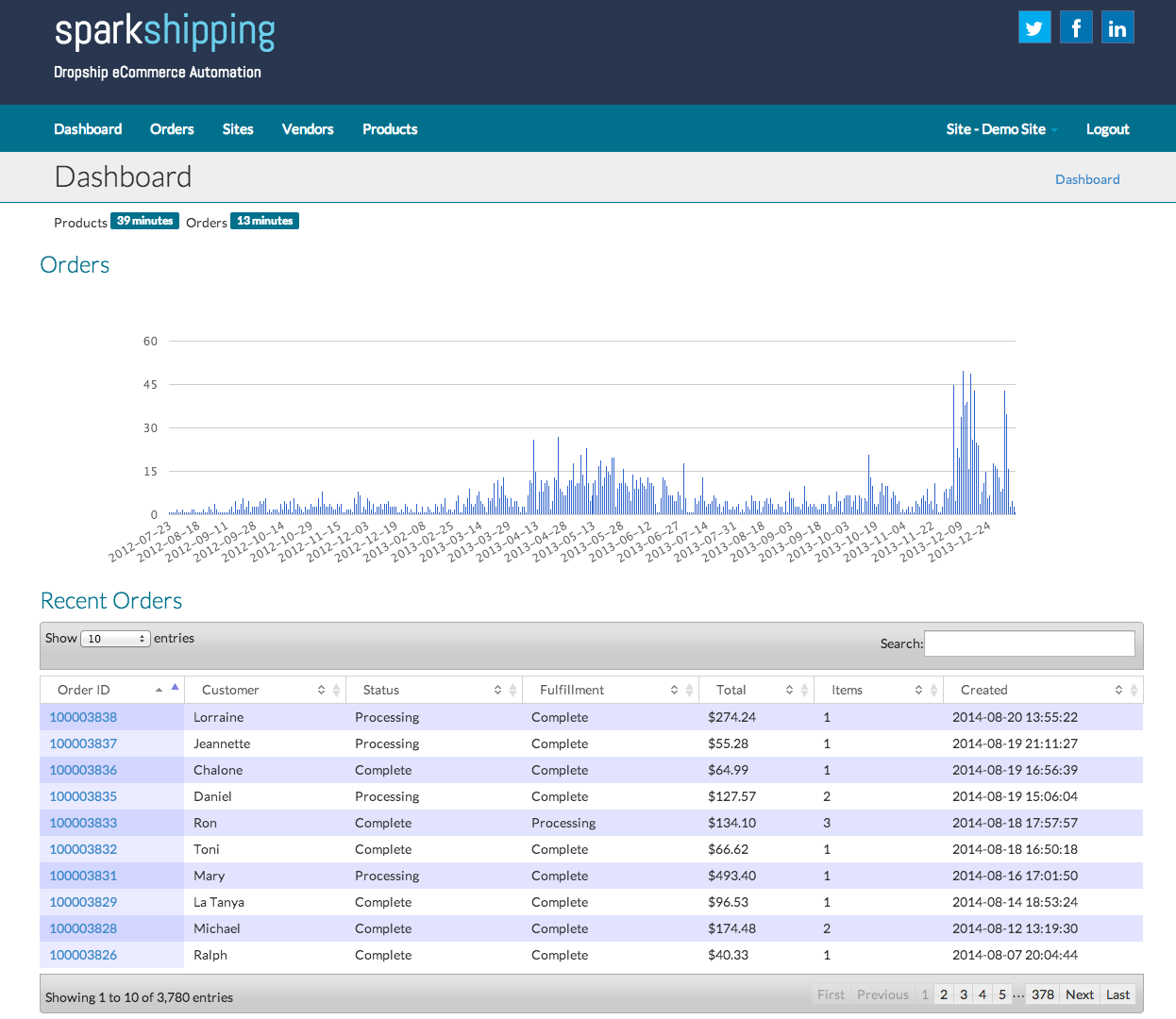Everything You Need To Know About Multichannel Inventory Management Software

The shift toward multichannel selling through brick-and-mortar stores, eCommerce sites, and digital marketplaces like Amazon and eBay has become a defining feature of today’s retail landscape—which makes having a multichannel inventory management system more important than ever.
Multichannel inventory management tools enable retailers to synchronize their inventory data across different sales channels, ensuring accurate stock levels and reducing the risk of overselling or stockouts.
Yet, a surprising portion of businesses are struggling with doing it effectively:
- 43% of businesses still use manual methods or don't track inventory at all.
- The average level of inventory accuracy in US retail operations is just 63%.
- Around 34% of businesses have unintentionally sold products that were unavailable in their inventory.
- Businesses can achieve up to a 10% reduction in total inventory costs by addressing overstocking and understocking issues.
Managing inventory across multiple online channels can be a real challenge for dropshipping businesses. As you expand your sales to various platforms, keeping track of inventory becomes increasingly complex.
While it might seem manageable to do it manually with just a couple of channels, the challenge multiplies when you're selling on numerous platforms.
In this blog, we explore everything you need to know about multichannel inventory management—why it’s so important for your eCommerce store, how to choose the right software, and how you can make it even more powerful with integrations from Spark Shipping.
What Is Multichannel Inventory Management?

Multichannel inventory management is a comprehensive approach aimed at overseeing, monitoring, and enhancing a company's inventory across various sales channels and physical locations.
It allows businesses to sync inventory and maintain stock visibility across all touchpoints. The result of this is a seamless shopping experience for customers and smoother inventory processes for the retailer.
Here’s how multichannel inventory management systems work:
1. Collect data from multiple suppliers
First, the multichannel inventory management system collects stock information from your warehouse and suppliers. This could include information about product names, quantities, prices, and locations.
2. Centralize inventory data
The multichannel inventory management software then centralizes all this data in one system, giving you a single dashboard with an overview of your entire inventory across all channels.
3. Provide real-time inventory updates across all channels
Whenever a sale is made on one channel, the inventory management software automatically updates the inventory levels on all the other channels in real-time. For example, if you sell a product in your online store, the software deducts one from your inventory everywhere else.
4. Send automated alerts and reorder points
When your inventory reaches a certain level, it can send you notifications to reorder more stock from your suppliers, ensuring you never run out of popular items.
One of the most powerful aspects of multichannel inventory management is the fact that information is shared across your business.
With this centralized system, all stakeholders have access to accurate inventory data, eliminating potential discrepancies and ensuring a seamless operation.
When inventory is managed correctly, customers can order from anywhere, receive their orders quickly, and are never inconvenienced by stock availability.
Businesses benefit from up-to-date inventory data, predictable stock levels, and high customer satisfaction.
|
💡 An Example of the Multichannel Inventory Management Process Say, for example, you own a boutique that sells jewelry in-store, at pop-up shops, online, and wholesale to other retailers. Managing inventory across these different channels can quickly become overwhelming. With multichannel inventory management software, you can track your inventory levels in real-time across all your sales channels and physical locations. For example, if you sell a necklace in-store, the inventory system automatically updates the on-hand stock levels across your online store and other sales channels so you don't oversell products you no longer have. In addition, when you receive new shipments of jewelry from your suppliers, the inventory system updates your stock levels across all channels, allowing you to fulfill orders promptly and avoid disappointing customers with out-of-stock items. |
How to Choose a Multichannel Inventory Management System

These days, it’s not enough to simply sell your products on your own website: you have to be competitive.
Other dropshippers are taking up their share of the market on multiple platforms. That means you need a bigger footprint to expand your own business and claim your piece of the pie.
To scale, you need to reach customers wherever they are, whether it's through your website, social media, or online marketplaces—and supporting your growth means investing in multichannel management software.
When choosing a system for your business, focus on features that simplify inventory control and support business growth.
Here's what to consider:
Automation capabilities
Look for a system that automates inventory management and adjustments, generates alerts for low stock levels, and facilitates automatic purchase orders with vendors based on inventory thresholds.
User-friendly interface
No matter how automated your multichannel inventory system is, humans still need to interact with it—that's why opting for a user-friendly interface is so important.
Look for an intuitive system that allows easy uploading of product photos and descriptions.
This ensures efficient cataloging and searching of products in your inventory library, which can facilitate product line expansion.
SKU generation
Look for systems that automatically generate SKUs, which helps by cataloging new inventory variations and creating barcoded labels. This feature reduces costs and enhances data accuracy.
Analytics
Prioritize systems offering real-time analytics for inventory forecasting and decision-making.
Access to sales, profit, COGS, and sell-through reports from any device connected to your POS can help track business analytics conveniently.
Integrations
Ensure seamless integration with other tools like staff scheduling and accounting software. If you have physical stores, adding support for delivery options like in-store pickup can boost sales with your local customers.
How to Implement Multichannel Inventory Management with Solutions From Spark Shipping
Spark Shipping's comprehensive suite of features that includes automated inventory updates, automated order fulfillment, and intelligent order routing, forms a robust multichannel inventory integration solution.
Our products enable businesses to streamline operations, maximize efficiency, and scale effectively in today's competitive eCommerce landscape.
Here’s how they work:
1. One-to-Many Mapping
If you’re a dropshipper, you've likely faced the dilemma of listing products that could potentially be fulfilled by multiple vendors, including your internal warehouse.
This scenario presents a unique challenge: each vendor provides different data for the same product, such as varying SKUs, identifiers, and costs. So, creating separate product listings for each vendor becomes necessary to accurately represent your inventory.
However, managing multiple listings for the same product can be time-consuming and inefficient. That’s where our One-to-Many Mapping solution comes in.
Instead of creating separate product listings for each vendor, we allow you to create one product listing in your store and map it to multiple vendors.
Here’s how it can help streamline your business:
Streamline processes: With a straightforward three-step process, you can easily link a single product listing to multiple vendors, saving you time and effort in managing your product catalog.
Easy mapping: Spark Shipping automatically links vendor-level data, including SKUs, identifiers, costs, and stock quantities, to the unique product ID in your store.
Efficient inventory management: Keep inventory levels accurate and up to date across all vendors, minimizing stockouts and overselling scenarios.
Intelligent order routing: With configurable routing rules, Spark Shipping intelligently routes orders to the best vendor based on factors like stock availability and cost, optimizing order fulfillment.
Seamless integration: Whether your vendors use different systems or protocols, Spark Shipping can handle various data formats, ensuring smooth integration with all your suppliers.
Optimized pricing: Automatically update pricing based on vendor-specific costs, ensuring competitive pricing across your product catalog.
2. Automated order fulfillment
Our automated order fulfillment system can integrate with multichannel inventory management solutions to provide a comprehensive approach to inventory and order management across multiple sales channels.
Features include:
Intelligent order routing
With our intelligent order routing feature, orders are automatically directed to the most suitable vendor or fulfillment center based on predefined rules, ensuring optimal efficiency and cost-effectiveness.
Flexible order formats
Our system supports a variety of order formats, including plain text email, CSV, XML, EDI, and API, ensuring seamless integration with your vendors' systems to simplify communication.
One-to-Many Mapping
Our innovative One-to-Many mapping functionality enables you to link a single product to multiple vendors, facilitating seamless order routing and inventory management across your supply chain.
Customizable automation rules
Whether you prefer fully automated order routing or manual approval for certain orders, our system offers customizable automation rules to suit your specific business requirements and preferences.
3. Automated inventory updates

Spark Shipping's automated inventory updates feature offers a seamless solution for synchronizing inventory data with your vendors.
Here's how it can enhance your multichannel inventory management:
Real-time inventory synchronization
You can automate the process of updating inventory levels across all your vendors in real time. This ensures that you always have accurate stock information available, minimizing the risk of overselling and stockouts.
Flexible integration options
Spark Shipping supports various integration methods, including FTP, SFTP, HTTP, API, XML, and manual uploads, ensuring compatibility with your vendors' inventory publishing methods.
Minimum inventory limits
Set minimum inventory thresholds to prevent stockouts and ensure that you can always fulfill customer orders. By defining minimum inventory levels, you can proactively manage inventory replenishment and avoid disruptions to your operations.
Scalable technology
Our scalable technology infrastructure enables rapid inventory updates, even as your business grows.
Whether you're managing a small inventory or a vast product catalog, Spark Shipping can handle the task efficiently so your inventory management remains agile and responsive to your business needs.
Integration with multichannel sales platforms
Our product seamlessly integrates with popular shopping carts and multichannel sales platforms, including Shopify, BigCommerce, WooCommerce, Magento, Amazon, and eBay.
This integration enables you to manage inventory across all your sales channels from a centralized dashboard, simplifying multichannel inventory management and enhancing operational efficiency.
6 Tips to Boost Your Multichannel Inventory Management
In eCommerce, every click counts and every order matters.
With the right strategies, you can ensure seamless operations across various sales platforms, optimize stock levels, and meet customer demands efficiently.
Here are six practical tips to streamline your inventory management process:
1. Establish product minimums
Ensuring you always have enough inventory on hand is crucial for meeting customer demands.
Consider setting minimum thresholds above zero, especially for platforms like Amazon, where running out of stock can be detrimental.
By analyzing historical data, you can automate the reordering process and maintain optimal stock levels.
2. Forecast performance
Use past order data to accurately predict future demand.
By understanding sales patterns, including seasonal fluctuations, you can proactively adjust inventory levels to meet anticipated demand.
3. Measure your performance
Consolidate data from all your sales channels into one system to simplify analysis.
Focus on key performance indicators like turnover, profit margins, and fulfillment rates to gain actionable insights into your business's performance.
4. Monitor SKUs and sales channels
Prioritize inventory management for top-selling SKUs to prevent stockouts and maintain customer satisfaction.
By monitoring sales performance on each channel and optimizing inventory levels accordingly, you can maximize sales and minimize excess inventory costs.
5. Watch product pricing
Customize product pricing based on the specific platform or marketplace to account for platform-specific fees and costs.
Remember to incorporate additional expenses into your pricing strategy, such as credit card processing fees on platforms like Shopify and BigCommerce, and category or listing fees on Amazon and eBay.
Prices may vary across channels due to different fee structures, and you’ll need to adjust your pricing accordingly to ensure profitability.
6. Integrate and automate
Utilize automation tools to synchronize inventory data and streamline order processing across channels.
By centralizing inventory information and reducing manual tasks, you can improve efficiency and scalability in your eCommerce operations.
Master Multichannel Inventory Management with Spark Shipping
In the ever-expanding world of multichannel selling, keeping your inventory in check and ensuring you can quickly fulfill orders have become more important than ever before.
Thankfully, with the help of reliable multichannel inventory management software, businesses can synchronize their inventory data across all their sales channels and locations.
This not only helps prevent the headaches of overselling or stockouts, but also improves the overall shopping experience for customers.
Whether you’re a small boutique or a large eCommerce dropshipping enterprise, efficient inventory management can be the difference between a business that’s thriving or simply surviving.
With the right tools and strategies in place, you can proactively manage inventory levels, accurately forecast demand, and optimize order fulfillment processes.
Don't let inefficient inventory management hold your business back. Get started with Spark Shipping and schedule a demo now.3
Popular Posts
Posts by Topic
- Dropshipping (10)
- Dropshipping Automation (5)
- Dropship Suppliers (4)
- EDI (3)
- Pricing Strategy (3)
- Amazon Seller Central (2)
- Automotive Dropshipping (2)
- Conversion Rate Optimization (2)
- Dropshipping Products (2)
- Order Management (2)
- Shipping (2)
- Vendor Product Catalog (2)
- AI Dropshipping (1)
- Dean Soto (1)
- Feature Announcement (1)
- Online Empire Academy (1)
- Product Optimization (1)
- Walmart Marketplace (1)
- referral marketing (1)